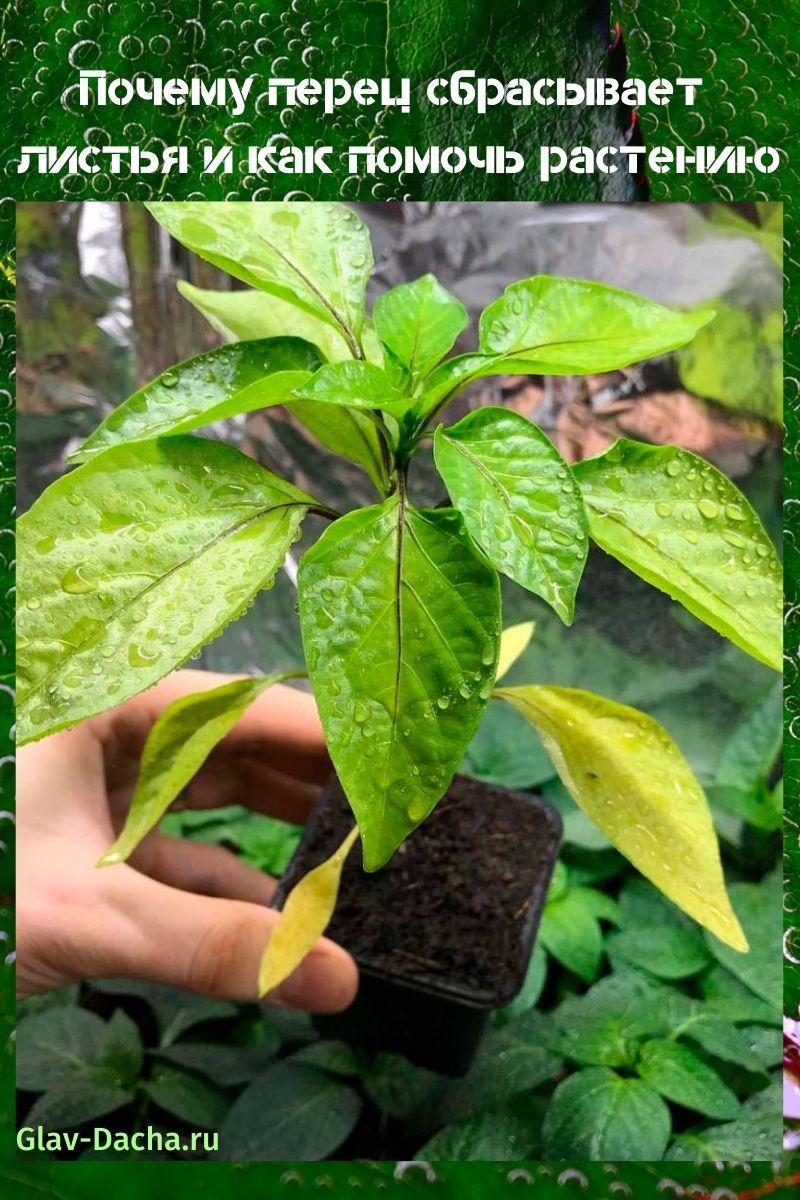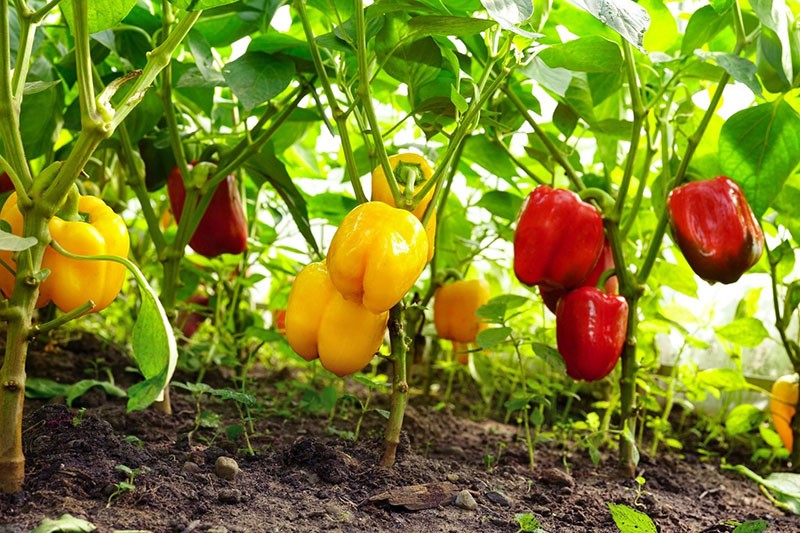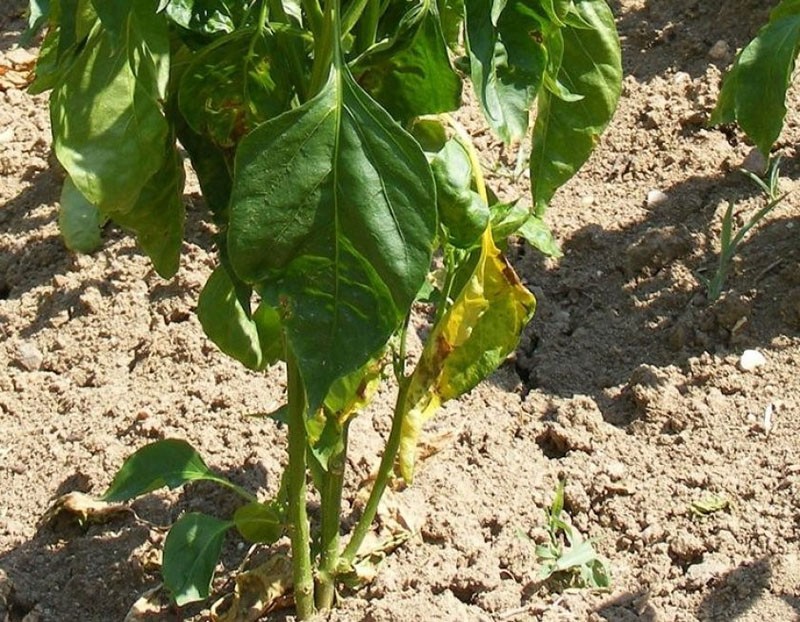Why pepper sheds leaves and how to help the plant
 When growing such a capricious and demanding vegetable crop as bell pepper, gardeners face many problems, one of which is leaf dropping. The reasons why peppers shed their leaves can be different - from violations in cultivation techniques or improper care to damage by diseases and pests. To restore the full growth and fruiting of pepper, you need to eliminate the cause of the leaf dropping.
When growing such a capricious and demanding vegetable crop as bell pepper, gardeners face many problems, one of which is leaf dropping. The reasons why peppers shed their leaves can be different - from violations in cultivation techniques or improper care to damage by diseases and pests. To restore the full growth and fruiting of pepper, you need to eliminate the cause of the leaf dropping.
Why pepper sheds leaves - the main reasons

Why do the leaves of peppers turn yellow and fall off:
- agrotechnical mistakes - improper watering, lack or excess of fertilizers;
- the influence of the external environment - temperature or humidity, lighting;
- damage by insect pests;
- diseases.
 The reasons why peppers shed their leaves can affect both young seedlings and mature plants. Therefore, you need to monitor the state of the culture and immediately take action when the foliage turns pale, yellowing or falling off.
The reasons why peppers shed their leaves can affect both young seedlings and mature plants. Therefore, you need to monitor the state of the culture and immediately take action when the foliage turns pale, yellowing or falling off.
Agrotechnical errors
 One of the most common reasons why peppers shed their leaves is gardener mistakes when growing this crop. Improper watering is very harmful for the plant - an excess of moisture and its lack leads to loss of foliage and stunting.
One of the most common reasons why peppers shed their leaves is gardener mistakes when growing this crop. Improper watering is very harmful for the plant - an excess of moisture and its lack leads to loss of foliage and stunting.
Stagnation of moisture in the soil with excessive watering disrupts normal air exchange, the root system does not receive enough oxygen and begins to rot. This leads to the appearance of brown-brown spots on the stems and leaves, as well as their abscission. This problem is most common in young seedlings.
A common reason why the lower leaves of a pepper fall off is insufficient watering. In this case, the foliage dries up, the plant can shed ovaries and buds. Also, do not use cool running water to moisten bell peppers. It causes hypothermia of the roots and causes them to rot.
The reason for yellowing and dropping of pepper leaves may be a lack of minerals:
- nitrogen - pepper leaves turn yellow, white streaks appear on them;
- phosphorus - the leaf plate turns yellow, but the veins on it remain green;
- iron - the upper leaves most often suffer from a deficiency of this element;
- potassium - the leaves begin to turn yellow at the edges, curl down and deform.
When growing bell peppers, care must be taken that the plant does not grow in cramped conditions. With overly thickened plantings, the roots of the seedlings get tangled, they lack oxygen, nutrients and moisture. In such cases, they "try" to get rid of the foliage as quickly as possible.
Influence of external factors
 If the leaves of pepper seedlings turn pale, this may indicate insufficient lighting. Bell pepper belongs to the light-loving and heat-loving crops, which are very “painful” to tolerate sharp fluctuations in air temperature, drafts and precipitation.
If the leaves of pepper seedlings turn pale, this may indicate insufficient lighting. Bell pepper belongs to the light-loving and heat-loving crops, which are very “painful” to tolerate sharp fluctuations in air temperature, drafts and precipitation.
What to do if pepper seedlings shed their leaves - you need to provide the plant with an optimal temperature regime within + 24-26 ° С during the day and + 17-20 ° С at night.When the air temperature drops below the minimum mark, the growth of the pepper slows down, and the foliage begins to turn yellow and crumble.
It is very important to choose the right place for growing pepper.:
- For planting young seedlings, it is advisable to choose an area that is evenly illuminated throughout the day.
- Pepper belongs to light-loving crops that need a day of light for at least 12 hours. In this case, the light must necessarily be diffused, direct sunlight can cause a serious burn of fragile leaves.
- Clay, heavy and acidic soils are not suitable for growing bell peppers. Such soils do not provide full air and water exchange, which leads to decay and death of the root system.
The best option for pepper is a breathable, light and nutritious soil with a neutral reaction.
Damage by pests
 One of the reasons why pepper leaves fall on the windowsill, in open or closed ground, is damage by pests. They feed on the root system or plant juices, impairing its growth and development.
One of the reasons why pepper leaves fall on the windowsill, in open or closed ground, is damage by pests. They feed on the root system or plant juices, impairing its growth and development.
The main pests of bell pepper:
- Spider mites - This insect can be identified by the cobweb covering the leaves and stems of the crop. The leaf plates become gray, faded, covered with black dots.
- Whiteflies - The most common attack on peppers grown in greenhouses. Insects live on the underside of leaves and feed on their juices. As a result, the leaf plates turn yellow, become covered with a sticky liquid and fall off.
- Aphids - leaf plates affected by aphids become sticky, with a glossy surface. Most pests can be found on the inside of the leaves.
An equally common problem in the cultivation of sweet peppers is the defeat of thrips or bears. Larvae and adults of thrips feed on plant juices, bears feed on roots. As a result, the pepper begins to wither quickly, its leaves dry, turn yellow and fall off.
Diseases of pepper
 Pepper is a vegetable crop that is susceptible to many diseases. They cause not only massive leaf fall, but also lead to the death of the plant.
Pepper is a vegetable crop that is susceptible to many diseases. They cause not only massive leaf fall, but also lead to the death of the plant.
Common diseases:
- Black spot is a bacterial infection that develops rapidly in the absence of ventilation and high humidity. Rounded brownish-brown spots appear on the leaves, they gradually turn yellow and fall off.
- Verticillium wilt is a fungal disease that affects young plants before flowering. The internodes begin to deform, the plant lags behind in development, the foliage becomes small and begins to crumble.

- Late blight - the main symptom of this disease is rotting of the root collar and stem in the base area. Pepper with late blight fades green, at advanced stages, the stems and foliage are covered with brown-brown spots.

Bell peppers can also be affected by other diseases - powdery mildew, bacterial cancer. It is very important to regularly inspect the plant, carry out preventive treatment against diseases and insect pests.
What to do when leaves fall
 Falling leaves are a common problem for both young seedlings and mature plants. First of all, you need to establish the reason for the dropping of the leaves, and then take measures to save the pepper.
Falling leaves are a common problem for both young seedlings and mature plants. First of all, you need to establish the reason for the dropping of the leaves, and then take measures to save the pepper.
What to do if pepper leaves fall:
- In case of insufficient or excessive moisture, it is necessary to adjust the irrigation regime - for seedlings, daily irrigation with small portions (150 ml) of warm water is required. Adult bushes should be watered with water at room temperature, in the early morning or evening.

- Nitrogen deficiency requires the introduction of fertilizers containing this component - for example, Azogran-B.
- In case of damage by insect pests, treatment with insecticidal preparations is carried out - from the spider mite Apollo, Kleschevit or Aktellik, from the aphid Keltan or Karbofos.
- With late blight, the plant is treatable. All affected bushes must be dug up and burned.
- In case of insufficient nutrition, the seedlings can be treated with a solution of any growth stimulator - Zircon, Epin-Extra, sodium humate.
 The yellowing and falling of the leaves of bell pepper is an alarming signal indicating a violation of the agricultural technology of its cultivation, an error in care or illness. The defeat of the plant by insect pests is also accompanied by wilting of foliage and growth arrest. It is very important to timely eliminate all errors in the care of pepper - this will ensure its rapid growth and high yield.
The yellowing and falling of the leaves of bell pepper is an alarming signal indicating a violation of the agricultural technology of its cultivation, an error in care or illness. The defeat of the plant by insect pests is also accompanied by wilting of foliage and growth arrest. It is very important to timely eliminate all errors in the care of pepper - this will ensure its rapid growth and high yield.